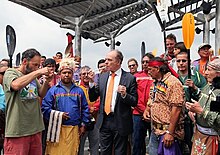

| New Netherland series |
|---|
| Exploration |
| Fortifications: |
| Settlements: |
| The Patroon System |
|
| People of New Netherland |
| Flushing Remonstrance |
 |
The Two Row Wampum Treaty, also known as Guswenta or Kaswentha and as the Tawagonshi Agreement of 1613 or the Tawagonshi Treaty, is a mutual treaty agreement, made in 1613 between representatives of the Five Nations of the Haudenosaunee (or Iroquois) and representatives of the Dutch government in what is now upstate New York.[1] The agreement is considered by the Haudenosaunee to be the basis of all of their subsequent treaties with European and North American governments, and the citizens of those nations, including the Covenant Chain treaty with the British in 1677 and the Treaty of Canandaigua with the United States in 1794.
The treaty is spiritually and culturally revered and widely accepted among the Indigenous peoples in the relevant territories, and documented by the wampum belts and oral tradition.[1] However, in more recent years the authenticity of the later, written versions of the agreement have been a source of debate, with some scholarly sources maintaining that a treaty between the Dutch and the Mohawk nations did not take place or took place at a later date.[2][3][4][5][6][7][8][9] In August 2013, the Journal of Early American History published a special issue dedicated to exploring the Two Row Tradition.[10]
- ^ a b Coin, Glenn (August 9, 2012). "400 years later, a legendary Iroquois treaty comes under attack". The Post-Standard. Retrieved 20 August 2013.
If the paper treaty is fake, Starna said, so is the idea of any formal agreement made in 1613.
- ^ Jennings, Francis (1995), The History And Culture Of Iroquois Diplomacy An Interdisciplinary Guide to the Treaties of the Six Nations and Their League, Syracuse University Press, ISBN 9780815626503
- ^ Venables, Robert. "The 1613 Treaty" (PDF). www.peacecouncil.net. Retrieved 2013-01-06.
- ^ Fenton, William Nelson (1998), The Great Law and the Longhouse: A Political History of the Iroquois Confederacy, University of Oklahoma Press, p. 269, ISBN 0-8061-3003-2
- ^ Benjamin, Vernon (2000). "The Tawagonshi Agreement of 1613 A Chain of Friendship in the Dutch Hudson Valley". www.mindserpent.com. Retrieved 2013-01-06.
- ^ Venables, Robert W. (September 2012). "An Analysis of the 1613 Tawagonshi Treaty". Onondaga Nation. Retrieved 2013-01-06.
- ^ Coin, Glenn (August 9, 2012). "400 years later, a legendary Iroquois treaty comes under attack". The Post-Standard. Retrieved 2013-01-06.
- ^ Van der Sijs, Nicoline (August 2012), "'De laatste spreker van Low Dutch' L.G. van Loon vervalste de geschiedenis van het Nederlands in Amerika (The last speaker of Low Dutch LG van Loon LG falsified the history of the Dutch in America)" (PDF), Onze Taal
- ^ Gehring, Charles T.; Starna, William A. (2012). "Revisiting the Fake Tawagonshi Treaty of 1613" (PDF). New York State Historical Society. Retrieved 2012-01-06.
- ^ Various authors (2013). "Special Issue: Early Iroquoian-European Contacts: The Kaswentha Tradition, the Two Row Wampum Belt, and the Tawagonshi Document, 2013". Journal of Early American History. 3. ISSN 1877-0223. Retrieved 12 March 2016.